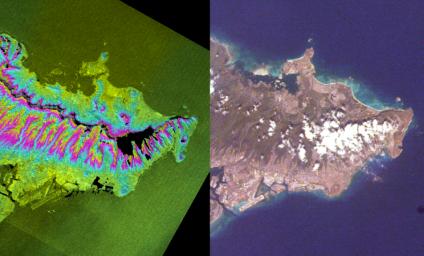These two images of the eastern part of the island of Oahu, Hawaii provide information on regional topography and show the relationship between urban development and sensitive ecosystems. On the left is a topographic radar image collected by the Shuttle Radar Topography Mission (SRTM.) On the right is an optical image acquired by a digital camera on the Space Shuttle Endeavour, which carried SRTM. Features of interest in this scene include Diamond Head (an extinct volcano at the lower center), Waikiki Beach (just left of Diamond Head), the Punchbowl National Cemetery (another extinct volcano, at the foot of the Koolau Mountains), downtown Honolulu and Honolulu airport (lower left of center), and Pearl Harbor (at the left edge.)
The topography shows the steep, high central part of the island surrounded by flatter coastal areas. The optical image shows the urban areas and a darker, forested region on the mountain slopes. The clouds in the optical image and the black areas on the topographic image are both a result of the steep topography. In this tropical region, high mountain peaks are usually covered in clouds. These steep peaks also cause shadows in the radar data, resulting in missing data "holes." A second pass over the island was obtained by SRTM and will be used to fill in the holes.
The left image combines two types of SRTM data. Brightness corresponds to the strength of the radar signal reflected from the ground, while colors show the elevation. Each color cycle (from pink through blue and back to pink) represents 400 meters (1,300 feet) of elevation difference, like the contour lines on a topographic map. This image contains about 2,400 meters (8,000 feet) of total relief. The optical image was acquired by the Shuttle Electronic Still Camera with a lens focal length of 64 millimeters (2.5 inches) for the Earth Knowledge Acquired by Middle school students (EarthKAM) project. EarthKAM has flown on five space shuttle missions since 1996. Additional information about EarthKAM is available at http://Earthkam.sdsc.edu/geo/ .
The Shuttle Radar Topography Mission (SRTM) was carried onboard the Space Shuttle Endeavor, which launched on February 11, 2000. It uses the same radar instrument that comprised the Spaceborne Imaging Radar-C/X-Band Synthetic Aperture Radar (SIR-C/X-SAR) that flew twice on the Endeavour in 1994. The mission is designed to collect three-dimensional measurements of the Earth's surface. To collect the 3-D data, engineers added a 60-meter-long (200-foot) mast, an additional C-band imaging antenna and improved tracking and navigation devices. The mission is a cooperative project between the National Aeronautics and Space Administration (NASA), the National Imagery and Mapping Agency (NIMA) and the German (DLR) and Italian (ASI) space agencies. It is managed by NASA's Jet Propulsion Laboratory, Pasadena, CA, for NASA's Earth Science Enterprise,Washington, DC.
Size: 35 by 35 kilometers (22 by 22 miles)
Location: 21.4 degrees North latitude, 157.8 degrees West longitude
Orientation: North at top
Original Data Resolution: SRTM, 30 meters (99 feet), EarthKAM Electronic Still Camera, 40 meters (132 feet)
Date Acquired: SRTM, February 18, 2000; EarthKAM, February 12, 2000
Image: NASA/JPL/NIMA

 Planetary Data System
Planetary Data System












